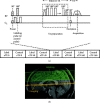Review of the Research Progress of Human Brain Oxygen Extraction Fraction by Magnetic Resonance Imaging
- PMID: 36304964
- PMCID: PMC9596244
- DOI: 10.1155/2022/4554271
Review of the Research Progress of Human Brain Oxygen Extraction Fraction by Magnetic Resonance Imaging
Abstract
In recent years, the incidence of cerebrovascular diseases (CVD) is increasing, which seriously endangers human health. The study on hemodynamics of cerebrovascular disease can help us to understand, prevent, and treat the disease. As one of the important parameters of human cerebral hemodynamics and tissue metabolism, OEF (oxygen extraction fraction) is of great value in central nervous system diseases. The use of BOLD (blood oxygen level dependent) effect offers the possibility to study cerebral hemodynamic and metabolic characteristics by MRI (magnetic resonance imaging) measurements. Therefore, this paper reviews the hemodynamic parameters of brain tissue, discusses the principles and methods of quantitative BOLD-based MRI measurements of OEF, and discusses the advantages and disadvantages of each method.
Copyright © 2022 Zini Jian et al.
Conflict of interest statement
The authors declare that there is no conflict of interests regarding the publication of this paper.
Figures










Similar articles
-
Blood oxygenation level-dependent (BOLD)-based techniques for the quantification of brain hemodynamic and metabolic properties - theoretical models and experimental approaches.NMR Biomed. 2013 Aug;26(8):963-86. doi: 10.1002/nbm.2839. Epub 2012 Aug 28. NMR Biomed. 2013. PMID: 22927123 Free PMC article. Review.
-
Multi-Parametric Evaluation of Cerebral Hemodynamics in Neonatal Piglets Using Non-Contrast-Enhanced Magnetic Resonance Imaging Methods.J Magn Reson Imaging. 2021 Oct;54(4):1053-1065. doi: 10.1002/jmri.27638. Epub 2021 May 6. J Magn Reson Imaging. 2021. PMID: 33955613 Free PMC article.
-
Cerebral oxygen extraction fraction MRI: Techniques and applications.Magn Reson Med. 2022 Aug;88(2):575-600. doi: 10.1002/mrm.29272. Epub 2022 May 5. Magn Reson Med. 2022. PMID: 35510696 Free PMC article. Review.
-
Calibrated MRI to evaluate cerebral hemodynamics in patients with an internal carotid artery occlusion.J Cereb Blood Flow Metab. 2015 Jun;35(6):1015-23. doi: 10.1038/jcbfm.2015.14. Epub 2015 Feb 25. J Cereb Blood Flow Metab. 2015. PMID: 25712500 Free PMC article.
-
Quantitative BOLD: mapping of human cerebral deoxygenated blood volume and oxygen extraction fraction: default state.Magn Reson Med. 2007 Jan;57(1):115-26. doi: 10.1002/mrm.21108. Magn Reson Med. 2007. PMID: 17191227 Free PMC article.
Cited by
-
Research Progress on Glioma Microenvironment and Invasiveness Utilizing Advanced Multi-Parametric Quantitative MRI.Cancers (Basel). 2024 Dec 29;17(1):74. doi: 10.3390/cancers17010074. Cancers (Basel). 2024. PMID: 39796702 Free PMC article. Review.
-
Oxygen extraction fraction changes in ischemic tissue from 24-72 hours to 12 months after successful reperfusion.J Cereb Blood Flow Metab. 2025 Sep;45(9):1748-1759. doi: 10.1177/0271678X251333940. Epub 2025 Apr 12. J Cereb Blood Flow Metab. 2025. PMID: 40219845 Free PMC article.
References
-
- Cho J., Zhang S., Kee Y., et al. Cluster analysis of time evolution (CAT) for quantitative susceptibility mapping (QSM) and quantitative blood oxygen level-dependent magnitude (qBOLD)-based oxygen extraction fraction (OEF) and cerebral metabolic rate of oxygen (CMRO2) mapping. Magnetic Resonance in Medicine . 2020;83(3):844–857. doi: 10.1002/mrm.27967. - DOI - PMC - PubMed
Publication types
MeSH terms
Substances
LinkOut - more resources
Full Text Sources
Medical
Research Materials

